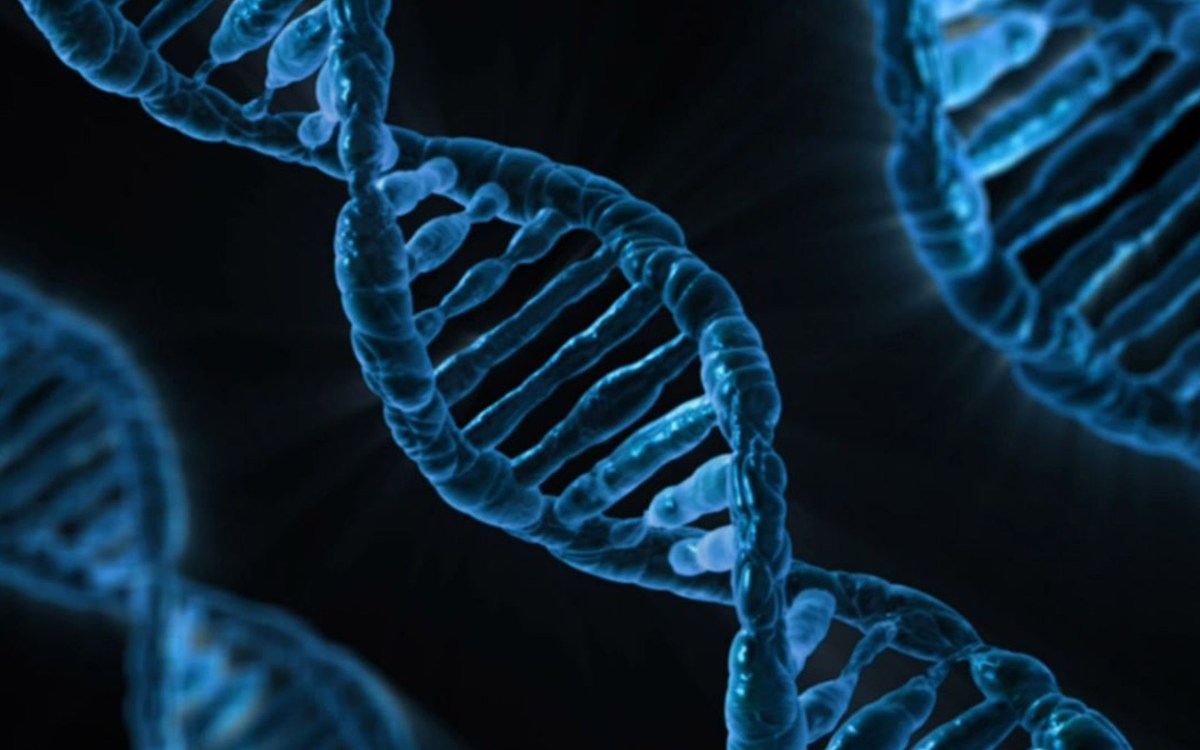
Cassandra Extavour, along with graduate student Leo Blondell (not pictured) are taking on what many thought to be an impossible task in understanding horizontal gene transfer.
Rose Lincoln/Harvard Staff Photographer
Horizontal helper
Evidence suggests part of key gene needed for insect reproduction came from bacterial genomes
In science, as in life, timing can be everything.
So it was when Cassandra Extavour, Professor of Organismic and Evolutionary Biology and of Molecular and Cellular Biology, set out to understand whether horizontal gene transfer — the process of passing genes between organisms without sexual reproduction — might be responsible for part of the makeup of a gene, known as oskar, that plays a critical role in the creation of germ cells in some insects.
Over the last decade, Extavour pitched the project to graduate students more than 10 times. They would investigate the idea but, ultimately, decide it was too complex and unwieldy.
Enter Leo Blondel.
As a first-year graduate student in the Molecules, Cells, and Organisms (MCO) program, in which students complete rotations in various labs before selecting one to join, Blondel was able to provide the strongest suggestive evidence yet that at least part of oskar actually came from bacterial genomes. The findings are described in a paper published in the journal eLife.
“I think this definitely moves the ball forward from where it was before, which was basically that we had no clue, and [our finding] basically says here are these lines of evidence for something that seems very likely,” Blondel said. “And it definitely improves the understanding of this particular gene. This particular gene appears out of nowhere in evolution and in only 480 million years becomes one of the most essential genes in the reproduction of insects, and the question was always: Where does it come from?”
To answer that question, Blondel performed a phylogenetic analysis — long the gold standard in proving horizontal gene transfer — and the results showed part of oskar’s sequence in insects is actually most closely related to a sequence found in bacteria.
It’s a finding that sheds new light on a gene that has long fascinated biologists.
“This gene is really interesting to people who work on germ cells because the phenotype if you have a mutation in this gene is that you have no germ cells,” Extavour said. “It was first identified in fruit flies, where it’s expressed in one corner of the embryo, which is where the germ cells form.”
Later studies revealed that oskar was sufficient by itself to produce functional germ cells, a feat that, even today, no other gene has demonstrated.
“One of the most important messages of the paper is to say maybe it’s time to look at things differently, because there may be something we’re completely missing that could change our understanding of biology.”
Leo Blondel
“But the one thing that has always been mysterious about oskar is where did it come from,” Extavour said. “For many decades, it was only found in fruit flies, then it was found in a couple mosquitos and a wasp. We found it in crickets a few years ago, and since then we’ve found a number of additional examples, but they’re all insects.
“And when we look at the sequence of the gene, it just doesn’t look like anything around,” she continued. “But if we look closely, there are two domains that look like domains we see in other organisms. One is called the LOTUS domain and the other is called OSK — short for oskar. The LOTUS domain looks like something people have found in many other eukaryotic proteins, but the thing that OSK is most similar to is not a sequence from any animal or eukaryote, but to bacterial sequences.”
Could it be, Extavour wondered, that those two separate parts of a single protein were actually co-opted from two different sources?
“I thought, ‘If that’s true, then, because we don’t think animals and bacteria reproduce with each other, that would have to occur through horizontal gene transfer,’” she said.
Finding evidence for that, however, proved frustratingly tricky.
Extavour first suggested the idea to a graduate student in 2008, but he quickly realized the project would be a lot to tackle, since the analysis would require collecting all the sequences that might be related to oskar, and then using statistics to break down whether and how they are related.
“The problem is that oskar evolves faster than the average gene,” Extavour said. “That means it’s hard to unambiguously identify the sequences that may be oskar’s relatives because they’re changing so fast.”
The project was picked up several years later by another grad student, Extavour said, who suggested that instead of searching for genes whose entire sequence appeared related to oskar, she search for genes that had sequences similar to either the LOTUS or OSK domains.
“She was able to identify about 100 new possible relatives from other insects that we hadn’t known had oskar before,” Extavour said.
Again, though, the project stalled as the student realized it would be too large to take on while she completed her degree.
Extavour later brought the project to Blondel, who remembers being intrigued, but not surprised by the idea.
“To me, there was already enough evidence to start forming a hypothesis that this might be the case,” he said. “It needed a lot more work, but the idea was there. But the one thing I said to her was that I had no idea how to prove it.”
Nevertheless, Blondel went to work and was able to add another 50 possible relatives to the list before creating a phylogenetic analysis, and the results showed that while the LOTUS domain is likely related to a similar sequence found in other animal proteins, the OSK domain is likely related to bacterial sequences.
The analysis didn’t end there. Blondel also found evidence that the insect and bacterial sequences have the same genetic “accent.”
That accent, Extavour said, has to do with how the bacterial and the insect genes use codons — three-base segments of DNA that code for a particular amino acid.
But much like a spoken accent, that codon-use signature can fade over time, and given the age of the oskar gene — scientists believe it to be approximately 500 million years old — Extavour said she and Blondel didn’t expect to detect much, if any, of that signature.
Still, the pair measured codon use in oskar four different ways, and while three turned up no evidence of differences, one did suggest that the OSK domain is different than the rest of the gene.
Extavour and Blondel were even able to come up with a hypothesis about where the foreign OSK sequence may have come from.
“We noticed that many of the sequences that appear to be closely related to the OSK domain came from bacteria that are sometimes endosymbionts — bacteria that live inside insects,” Extavour said. “There are many insect endosymbionts that don’t just live inside the animal, they live in the cytoplasm of the cells … and not just any cells, but germ cells.
“One of the best-studied insect endosymbionts is called Wolbachia, which lives inside the cytoplasm of germ cells, and some of the best-documented examples of horizontal gene transfer from bacteria to an insect have been from Wolbachia,” she continued. “So if you are living inside the cell that contains the DNA that is going to go into the next generation, maybe some of your DNA can make it into that germ cell nucleus and now you’re contributing to the next generation’s genome.”
While the paper offers important insights into a gene that is critical for insect reproduction, Blondel hopes it may offer other biologists a new approach to finding similar insights in other genes.
“This paper is the best evidence we can gather that this is the most likely scenario, but we can’t prove it in the sense that this is something that happened at least 450 million years ago,” he said. “But to me, one of the most important messages of the paper is to say maybe it’s time to look at things differently, because there may be something we’re completely missing that could change our understanding of biology. There are no tools scanning for this right now — no one is looking at the domain granularity in genes.”
This research was supported with funding from Harvard University.








